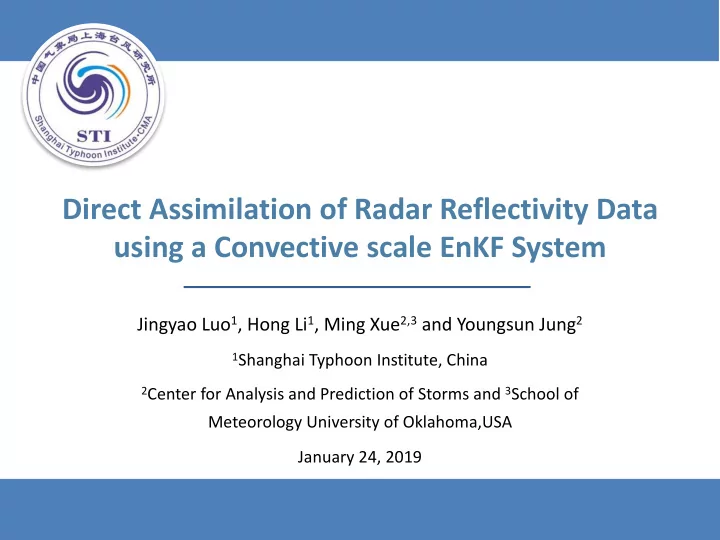

Direct Assimilation of Radar Reflectivity Data using a Convective scale EnKF System Jingyao Luo 1 , Hong Li 1 , Ming Xue 2,3 and Youngsun Jung 2 1 Shanghai Typhoon Institute, China 2 Center for Analysis and Prediction of Storms and 3 School of Meteorology University of Oklahoma,USA January 24, 2019
Motivation n Tropical cyclone(TC) intensity forecast is still a challenging problem in research and operational practice. n Radar is one of few observation platform capable of observing TC internal structure and circulation of precipitation at high spatial and temporal resolution. n EnKF is able to deal with complex ice and multi-moment microphysics and more suitable to assimilate radar data(Vr and Z) directly.
GSI-based EnKF System The reflectivity operator for double-moment is developed by CAPS: n Milbrandt and Yau (2005)
Experimental design Forecast model: WRF-ARW v3.9.1,3km n DA systems: GSI-EnKF, 40members n First Cycle Starts OBS: composite radar reflectivity n GFS analysis IC+perturbations Domain and Obs Deterministic forecast with 5h forecast 1h DA ensemble mean(Thompson) 12Z28 EnKF every Deterministic forecast with 15minutes ensemble mean(noDA) 40-mem With Z 11Z28 06Z28 06Z29
EnKF for Radar DA with a 2-Moment Microphysics Scheme 𝑣 1 𝑣 " 𝑤 1 𝑤 " 𝑥 1 Radar data: 𝑞 1 𝑥 " 𝜄 1 Z=Z(q r +q s +q g ) 𝜄 " 𝑞 1 𝑨 1 𝑞 " 1 1 𝑟 ( 𝑟 ( " 𝑟 ( 1 1 𝑟 * 𝑟 ) = + 𝐿 𝑎 − 𝐼 " 𝑟 ) K is the Kalman Gain, a function of 1 1 𝑟 - " 𝑟 * 𝑟 * background and obs error covariances 1 " 1 𝑟 + 𝑟 , 𝑟 + " 𝑟 , 1 1 H is the observation operator 𝑂 /0 𝑟 , " 𝑟 - 1 𝑟 - " 𝑂 /0 1 𝑂 /0
1 2 3 4 5 NoDA GSI EnKF Radar DA Radar- DA 11Z 12Z Background is stronger bkg =NoDA Z Obs Radar-DA(ana)
1 2 3 4 5 NoDA GSI EnKF Radar DA Radar- DA 11Z 12Z Z Obs NoDA Radar-DA(bkg) Radar-DA(ana)
1 2 3 4 5 NoDA GSI EnKF Radar DA Radar- DA 11Z 12Z NoDA Z Obs Radar-DA(ana)
RMS Innovation 201805281200
Why Radar DA is better? Hydrometers analysis Increment First Cycle qr All hydrometers decreased after radar DA. qs qi
Large-scale variables were Other variables updated correctly. First Cycle Wind-850hpa W T Dynamic consistent
NoDA vs. Radar-DA at final cycle NoDA Qi Qs Qr Qnr Radar-DA Qi Qs Qr Qnr
Track Forecast
Intensity Forecast NoDA Radar-DA Best-Track Positive Impact
precipitation forecasts Z Observation NoDA 1-hour forecast Radar-DA
precipitation forecasts Z Observation NoDA 2-hour forecast Radar-DA
Additional Experiments Name Radar Z Mp-scheme DA Thompson-NoDA No Thompson Thomson Yes Thompson Lin_NoDA No Lin Lin Yes Lin
Summary n A convective-scale EnKF DA system was successfully applied to directly assimilate radar Z data for a TC case. n Radar Z assimilation has positive impact on both intensity and precipitation forecast, the impact on precipitation maintained at least 1 hour while the impact on intensity can last for 12 hours. n EnKF well updated not only hydrometers but also other cross-variables (u,v,t,w), so as to produce well-balanced analysis state.
Thanks for your attentions!
Recommend
More recommend